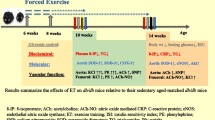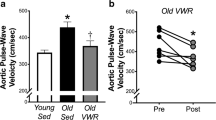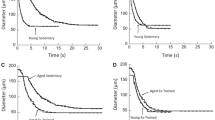Abstract
Aging is an independent risk factor for hypertension, and hypertension and insulin resistance commonly coexist in the elderly. This study was designed to examine the effects of aging-related insulin resistance on blood pressure (BP) and its underlying mechanisms, with specific focus on the role of exercise in reversing hypertensive response. Adult (6-month-old) and aging (24-month-old) male Sprague-Dawley rats were subjected to a 10 weeks free-of-loading swim training (60 min/day, 5 days/week). Arterial vasorelaxation, cardiac contraction, eNOS activation, and iNOS and gp91phox expression were determined. Under aging-related insulin resistance conditions, insulin infusion significantly elevated BP (P < 0.05). Aging caused significant endothelial dysfunction (P < 0.05 − 0.01), which was responsible for decreased arterial vasorelaxation to insulin. Aging attenuated myocardial contractile response to insulin, decreased eNOS expression and its phosphorylation by insulin, and increased iNOS and gp91phox expression in aging arteries (P < 0.01). Exercise improved insulin sensitivity, potentiated insulin’s positive inotropic effects, facilitated arterial vasorelaxation to insulin, increased arterial eNOS activation in adult and aging rats, and thus attenuated insulin resistance-related hypertensive response to insulin. Moreover, exercise markedly reversed increased iNOS and gp91phox expression in aging arteries. Inhibition of eNOS with Cavtratin or L-NAME significantly blocked exercise-facilitated arterial vasorelaxation to insulin and exercise-lowered BP response to insulin. In conclusion, these results demonstrate that endothelial dysfunction in response to insulin, but not insulin’s positive inotropic effects, plays an important role in the development of aging-related hypertension. The reversal of hypertensive response to insulin by exercise is most likely associated with improved insulin sensitivity in an eNOS-dependent manner and reduced oxidative and nitrative stresses.







Similar content being viewed by others
References
Anderson EA, Hoffman RP, Balon TW, Sinkey CA, Mark AL (1991) Hyperinsulinemia produces both sympathetic neural activation and vasodilation in normal humans. J Clin Invest 87:2246–2252
Barbagallo M, Resnick LM, Dominguez LJ, Licata G (1997) Diabetes mellitus, hypertension and ageing: the ionic hypothesis of ageing and cardiovascular-metabolic diseases. Diabetes Metab 23:281–294
Blackwell KA, Sorenson JP, Richardson DM, Smith LA, Suda O, Nath K, Katusic ZS (2004) Mechanisms of aging-induced impairment of endothelium-dependent relaxation: role of tetrahydrobiopterin. Am J Physiol Heart Circ Physiol 287:2448–2453
Bucci M, Gratton JP, Rudic RD, Acevedo L, Roviezzo F, Cirino G, Sessa WC (2000) In vivo delivery of the caveolin-1 scaffolding domain inhibits nitric oxide synthesis and reduces inflammation. Nat Med 6:1362–1367
Csiszar A, Ungvari Z, Edwards JG, Kaminski P, Wolin MS, Koller A, Kaley G (2002) Aging-induced phenotypic changes and oxidative stress impair coronary arteriolar function. Circ Res 90:1159–1166
Dengel DR, Hagberg JM, Pratley RE, Rogus EM, Goldberg AP (1998) Improvements in blood pressure, glucose metabolism, and lipoprotein lipids after aerobic exercise plus weight loss in obese, hypertensive middle-aged men. Metabolism 47:1075–1082
Duplain H, Burcelin R, Sartori C, Cook S, Egli M, Lepori M, Vollenweider P, Pedrazzini T, Nicod P, Thorens B, Scherrer U (2001) Insulin resistance, hyperlipidemia, and hypertension in mice lacking endothelial nitric oxide synthase. Circulation 104:342–345
Edwards JG, Tipton CM (1989) Influences of exogenous insulin on arterial blood pressure measurements of the rat. J Appl Physiol 67:2335–2342
Gabriely I, Ma XH, Yang XM, Atzmon G, Rajala MW, Berg AH, Scherer P, Rossetti L, Barzilai N (2002) Removal of visceral fat prevents insulin resistance and glucose intolerance of aging: an adipokine-mediated process? Diabetes 51:2951–2958
Gorlach A, Brandes RP, Nguyen K, Amidi M, Dehghani F, Busse R (2000) A gp91phox containing NADPH oxidase selectively expressed in endothelial cells is a major source of oxygen radical generation in the arterial wall. Circ Res 87:26–32
Grandi AM, Gaudio G, Fachinetti A, Zanzi P, Bianchi L, Ceriani L, Guasti L, Venco A (1997) Influence of family history of hypertension on insulin sensitivity in lean and obese hypertensive subjects. Eur J Clin Invest 27:774–779
Hamdy O, Ledbury S, Mullooly C, Jarema C, Porter S, Ovalle K, Moussa A, Caselli A, Caballero AE, Economides PA, Veves A, Horton ES (2003) Lifestyle modification improves endothelial function in obese subjects with the insulin resistance syndrome. Diabetes Care 26:2119–2125
Hu FB, Stampfer MJ (2005) Insulin resistance and hypertension: the chicken-egg question revisited. Circulation 112:1678–1680
Kelley GA, Kelley KS (2000) Progressive resistance exercise and resting blood pressure: a meta-analysis of randomized controlled trials. Hypertension 35:838–843
Kern W, Peters A, Born J, Fehm HL, Schultes B (2005) Changes in blood pressure and plasma catecholamine levels during prolonged hyperinsulinemia. Metabolism 54:391–396
Keymel S, Kalka C, Rassaf T, Yeghiazarians Y, Kelm M, Heiss C (2008) Impaired endothelial progenitor cell function predicts age-dependent carotid intimal thickening. Basic Res Cardiol [Epub ahead of print]
Kosegawa I, Katayama S, Kikuchi C, Kashiwabara H, Negishi K, Ishii J, Inukai K, Oka Y (1996) Metformin decreases blood pressure and obesity in OLETF rats via improvement of insulin resistance. Hypertens Res 19:37–41
Lakatta EG, Levy D (2003) Arterial and cardiac aging: major shareholders in cardiovascular disease enterprises: Part I: aging arteries: a “set up” for vascular disease. Circulation 107:139–146
Lauer T, Heiss C, Balzer J, Kehmeier E, Mangold S, Leyendecker T, Rottler J, Meyer C, Merx MW, Kelm M, Rassaf T (2008) Age-dependent endothelial dysfunction is associated with failure to increase plasma nitrite in response to exercise. Basic Res Cardiol 103:291–297
Li D, Qu Y, Tao L, Liu H, Hu A, Gao F, Sharifi-azad S, Grunwald Z, Ma XL, Sun JZ (2006) Inhibition of iNOS protects the aging heart against beta-adrenergic receptor stimulation-induced cardiac dysfunction and myocardial ischemic injury. J Surg Res 131:64–72
Ma H, Zhang HF, Yu L, Zhang QJ, Li J, Huo JH, Li X, Guo WY, Wang HC, Gao F (2006) Vasculoprotective effect of insulin in the ischemic/reperfused canine heart: role of Akt-stimulated NO production. Cardiovasc Res 69:57–65
Massion PB, Feron O, Dessy C, Balligand JL (2003) Nitric oxide and cardiac function: ten years after, and continuing. Circ Res 93:388–398
Miyazaki Y, Hirata A, Murakami H, Fukuoka M, Agata J, Higashiura K, Masuda A, Ura N, Shimamoto K (1998) Effects of aging on the insulin actions for the glucose metabolism and renal function in normotensives and essential hypertensives. Am J Hypertens 11:1056–1064
Mulders AC, Mathy MJ, Meyer ZH, Ter BM, Hajji N, Olthof DC, Michel MC, Alewijnse AE, Peters SL (2008) Activation of sphingosine kinase by muscarinic receptors enhances NO-mediated and attenuates EDHF-mediated vasorelaxation. Basic Res Cardiol [Epub ahead of print]
Paolisso G, Gambardella A, Verza M, D'Amore A, Sgambato S, Varricchio M (1992) ACE inhibition improves insulin-sensitivity in aged insulin-resistant hypertensive patients. J Hum Hypertens 6:175–179
Roberts CK, Vaziri ND, Barnard RJ (2002) Effect of diet and exercise intervention on blood pressure, insulin, oxidative stress, and nitric oxide availability. Circulation 106:2530–2532
Safar ME, Thomas F, Blacher J, Nzietchueng R, Bureau JM, Pannier B, Benetos A (2006) Metabolic syndrome and age-related progression of aortic stiffness. J Am Coll Cardiol 47:72–75
Saito I, Nishino M, Kawabe H, Wainai H, Hasegawa C, Saruta T, Nagano S, Sekihara T (1992) Leisure time physical activity and insulin resistance in young obese students with hypertension. Am J Hypertens 5:915–918
Schulman IH, Zhou MS, Jaimes EA, Raij L (2007) Dissociation between metabolic and vascular insulin resistance in aging. Am J Physiol Heart Circ Physiol 293:853–859
Schutzer WE, Reed JF, Mader SL (2005) Decline in caveolin-1 expression and scaffolding of G protein receptor kinase-2 with age in Fischer 344 aortic vascular smooth muscle. Am J Physiol Heart Circ Physiol 288:2457–2464
Sengstock DM, Vaitkevicius PV, Supiano MA (2005) Arterial stiffness is related to insulin resistance in nondiabetic hypertensive older adults. J Clin Endocrinol Metab 90:2823–2827
Sowers JR (1997) Insulin and insulin-like growth factor in normal and pathological cardiovascular physiology. Hypertension 29:691–699
Sowers JR (2004) Insulin resistance and hypertension. Am J Physiol Heart Circ Physiol 286:1597–1602
Sowers JR, Haffner S (2002) Treatment of cardiovascular and renal risk factors in the diabetic hypertensive. Hypertension 40:781–788
Sun MW, Qian FL, Wang J, Tao T, Guo J, Wang L, Lu AY, Chen H (2008) Low-intensity voluntary running lowers blood pressure with simultaneous improvement in endothelium-dependent vasodilatation and insulin sensitivity in aged spontaneously hypertensive rats. Hypertens Res 31:543–552
Tao L, Liu HR, Gao E, Teng ZP, Lopez BL, Christopher TA, Ma XL, Batinic-haberle I, Willette RN, Ohlstein EH, Yue TL (2003) Antioxidative, antinitrative, and vasculoprotective effects of a peroxisome proliferator-activated receptor-gamma agonist in hypercholesterolemia. Circulation 108:2805–2811
Thompson PD, Buchner D, Pina IL, Balady GJ, Williams MA, Marcus BH, Berra K, Blair SN, Costa F, Franklin B, Fletcher GF, Gordon NF, Pate RR, Rodriguez BL, Yancey AK, Wenger NK (2003) Exercise and physical activity in the prevention and treatment of atherosclerotic cardiovascular disease: a statement from the Council on Clinical Cardiology (Subcommittee on Exercise, Rehabilitation, and Prevention) and the Council on Nutrition, Physical Activity, and Metabolism (Subcommittee on Physical Activity). Circulation 107: 3109–3116
Whelton SP, Chin A, Xin X, He J (2002) Effect of aerobic exercise on blood pressure: a meta-analysis of randomized, controlled trials. Ann Intern Med 136:493–503
White MF (2003) Insulin signaling in health and disease. Science 302:1710–1711
Wisloff U, Najjar SM, Ellingsen O, Haram PM, Swoap S, Al-share Q, Fernstrom M, Rezaei K, Lee SJ, Koch LG, Britton SL (2005) Cardiovascular risk factors emerge after artificial selection for low aerobic capacity. Science 307:418–420
Wojtaszewski JF, Hansen BF, Gade, Kiens B, Markuns JF, Goodyear LJ, Richter EA (2000) Insulin signaling and insulin sensitivity after exercise in human skeletal muscle. Diabetes 49:325–331
Yu J, Bergaya S, Murata T, Alp IF, Bauer MP, Lin MI, Drab M, Kurzchalia TV, Stan RV, Sessa WC (2006) Direct evidence for the role of caveolin-1 and caveolae in mechanotransduction and remodeling of blood vessels. J Clin Invest 116:1284–1291
Yusuf S, Ostergren JB, Gerstein HC, Pfeffer MA, Swedberg K, Granger CB, Olofsson B, Probstfield J, Mcmurray JV (2005) Effects of candesartan on the development of a new diagnosis of diabetes mellitus in patients with heart failure. Circulation 112:48–53
Zhang C (2008) The role of inflammatory cytokines in endothelial dysfunction. Basic Res Cardiol 103:398–406
Zhang C, Park Y, Picchi A, Potter BJ (2008) Maturation-induces endothelial dysfunction via vascular inflammation in diabetic mice. Basic Res Cardiol 103:407–416
Zhang H, Li J, Li R, Zhang Q, Ma H, Ji Q, Guo W, Wang H, Lopez BL, Christopher TA, Ma X, Gao F (2008) Reduced cardiotropic response to insulin in spontaneously hypertensive rats: role of peroxisome proliferator-activated receptor-gamma-initiated signaling. J Hypertens 26:560–569
Zhang QJ, Li QX, Zhang HF, Zhang KR, Guo WY, Wang HC, Zhou Z, Cheng HP, Ren J, Gao F (2007) Swim training sensitizes myocardial response to insulin: role of Akt-dependent eNOS activation. Cardiovasc Res 75:369–380
Acknowledgments
This study was supported by National Science Fund for Outstanding Young Investigators (No. 30625033), grants from the National Natural Science Foundation of China (Nos. 30500577; 30800397), and National Basic Research Program of China (973 Program, No. 2007CB512106).
Author information
Authors and Affiliations
Corresponding author
Additional information
Returned for 1. Revision: 18 February 2008 1. Revision received: 11 August 2008
Returned for 2. Revision: 10 September 2008 2. Revision received: 15 September 2008
Electronic supplementary material
Rights and permissions
About this article
Cite this article
Li, QX., Xiong, ZY., Hu, BP. et al. Aging-associated insulin resistance predisposes to hypertension and its reversal by exercise: the role of vascular vasorelaxation to insulin. Basic Res Cardiol 104, 269–284 (2009). https://doi.org/10.1007/s00395-008-0754-8
Received:
Accepted:
Published:
Issue Date:
DOI: https://doi.org/10.1007/s00395-008-0754-8





